Environment & Conservation
PAPUA NEW GUINEA WILDLIFE AND ENVIRONMENT:
PNG
GOVERNMENT/NGO APPROACH TO CONSERVATION
Most people in developed countries understand
that it is very important to protect and
understand the environment and they are
in a better position to understand the effects
that industrialization has on the world's
environment. This, unfortunately is not
the case in lesser-developed areas of the
world. In a world with ever shrinking rain
forests, and disappearing plant and animal
species, Papua New Guinea is perhaps the
last frontier. Until recently its lush rain
forests and coral reefs had been largely
ignored, as many western and Asian countries
preferred to do business in other areas
closer to home. Now, however, PNG's vast
400,000 square kilometers of forest are
beginning to feel the effects of large-scale
logging and mining by large multi-national
corporations.
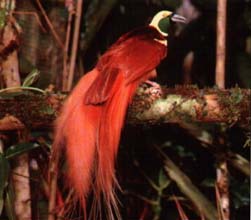 Papua New Guinea is a cornucopia of ecology.
It ranks within the top five most diverse
countries in the world with an estimated
21,000 types of higher plants, 242 species
of mammals, and 762 species of birds. It
also has one of the highest endemic rates
of wildlife anywhere in the world due to
the isolation of the island from the rest
of the Asian and Australian continents.
Along with its rugged terrain, which makes
transport difficult, PNG's forests have
been undesirable until recently because
of the traditional land tenure by-which
90% of the land is accounted for. Under
the Organic Law of PNG people do not own
land, but only lease it from the traditional
landowners, who are usually part of a clan
or tribe. Therefore, the government must
first consult with the local people before
entering into a contract on matters concerning
the use of traditional land. Laws are in
place to stringently regulate the use of
traditional land by foreigners and nationals,
and to police the various investment practices
that directly impinge on PNG's fragile but
rich natural environment.
Papua New Guinea is a cornucopia of ecology.
It ranks within the top five most diverse
countries in the world with an estimated
21,000 types of higher plants, 242 species
of mammals, and 762 species of birds. It
also has one of the highest endemic rates
of wildlife anywhere in the world due to
the isolation of the island from the rest
of the Asian and Australian continents.
Along with its rugged terrain, which makes
transport difficult, PNG's forests have
been undesirable until recently because
of the traditional land tenure by-which
90% of the land is accounted for. Under
the Organic Law of PNG people do not own
land, but only lease it from the traditional
landowners, who are usually part of a clan
or tribe. Therefore, the government must
first consult with the local people before
entering into a contract on matters concerning
the use of traditional land. Laws are in
place to stringently regulate the use of
traditional land by foreigners and nationals,
and to police the various investment practices
that directly impinge on PNG's fragile but
rich natural environment.
In response to international and local
outcry many conservation groups and non-
governmental organizations have begun to
move into PNG to help with a multitude of
issues. It is very hard to fully understand
or appreciate the impact these organizations
are having on PNG, but one thing is certain,
it would be difficult in this day and age
for countries in similar standing with PNG
to do without them. The Embassy seeks to
foster good relations with all these international
conservation groups because it sees them
as an integral part to ensuring that the
future of the country is preserved for future
generation. It is hoped the following information
will be helpful for the reader to understanding
both the activities of these organizations,
and the unique opportunity the world has
for preserving such a rich and increasingly
rare treasures.
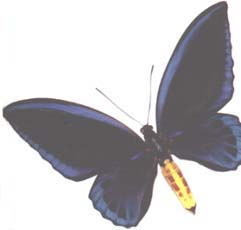 Conservation
International is a NGO based in Washington
DC. Its primary mission in Papua New Guinea
is to help communities understand and cope
with the dangers of unmanaged development,
logging, and mining. CI currently operates
3 sites in PNG and a fourth which is currently
in the planning stages. Conservation
International is a NGO based in Washington
DC. Its primary mission in Papua New Guinea
is to help communities understand and cope
with the dangers of unmanaged development,
logging, and mining. CI currently operates
3 sites in PNG and a fourth which is currently
in the planning stages.
Lakekamu Basin is located about
100 miles west of Port Moresby, and is situated
along the Lakekamu River. The project began
in 1992 when along with 17 students from
the University of Papua New Guinea and the
Foundation of the Peoples of the South
Pacific; CI scientists carried out a
Rapid Assessment expedition. This RAP helped
to document much of the area, which today
is the most documented site in PNG. Recently
an entomologist there documented over 250
different types of ants (second most in
the world after Peru)!
In this region CI also takes an active
role in providing basic healthcare and services
for the local people who have very little
contact with any other organizations. CI
is also working with the Conservation Policy,
and Conservation Enterprise Departments
to design and implement field research on
sustainable development schemes. Some of
these include small scale logging, galip
nut harvesting, and bio-prospecting businesses.
A small research station has been established
in Moril Bay, which CI hopes will increasingly
be used by visiting anthropologists and
scientists alike.
The Aroma Coastal Marine Management
Area is located approximately 75 miles
east of Port Moresby and is home to the
CI's current country director. It is currently
the only site where CI is working to restore
the environment along with preserving it.
This project area, which is about 3 years
old, is home to some of the thickest mangrove
forests in the world. These forests are
home to many types of tropical birds and
fish. Here CI is working with the community
to educate people about sustainable fishing
practices, and the need to preserve the
fragile coastal environment. They are also
working with the community to create laws
pertaining to these issues. Plans are already
underway for a Marine Watch Rangers program
consisting of trained community volunteers
to monitor this area.
Upon seeing the devastating effects of
logging to the west, the people of East
Pomio, on the island of New Britain
asked for CI's assistance. They formed the
East New Britain Social Action Committee,
and together with CI are working to create
alternative means of development for the
area. CI points out that this is a good
example of how individual communities in
PNG can be very proactive when it comes
to conservation of their precious land.
An enterprise specialist from CI should
be dispatched to the area by the end of
1999 to help the community directly.
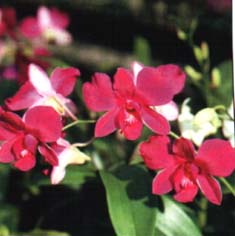 Milne Bay is the most recent
project site to be selected by CI as a priority
area. During the summer of '99 a delegation
from the province came to New York to meet
with members of the board of CI and raise
funding for their project. Current projections
look good and CI is hoping to have three
sites in Milne Bay up and running within
a year. Preliminary work includes developing
a plan for this area, which is blessed with
some of the most beautiful marine wildlife
and beaches in the world, and creating local
NGO's to work with. Soon CI and the government
of Milne Bay hope to be drawing eco-tourists
from all over the world to this virgin and
wild paradise. For more information on any
of these projects please contact the CI
website at www.conservation.org.
Milne Bay is the most recent
project site to be selected by CI as a priority
area. During the summer of '99 a delegation
from the province came to New York to meet
with members of the board of CI and raise
funding for their project. Current projections
look good and CI is hoping to have three
sites in Milne Bay up and running within
a year. Preliminary work includes developing
a plan for this area, which is blessed with
some of the most beautiful marine wildlife
and beaches in the world, and creating local
NGO's to work with. Soon CI and the government
of Milne Bay hope to be drawing eco-tourists
from all over the world to this virgin and
wild paradise. For more information on any
of these projects please contact the CI
website at www.conservation.org.
Although it is concerned primarily with
conservation in the United States The Nature
Conservancy has a few international
programs as well. It is, therefore very
significant that TNC chose to work extensively
in PNG. The Nature Conservancy over the
years has developed a large reservoir of
knowledge based on years of work and research
in the Solomon Islands. The very successful
sustainable fishing programs developed there
are now being duplicated at Kimbe Bay
in West New Britain. Here TNC is working
with Mahoni na Dari ("Guardians of
the Sea") and the European Union to
implement a conservation program aimed at
protecting the unique reef systems found
there. The project focuses on deep water
fishing practices, which relieves pressure
from the over-harvested reef fish, and educating
the people on sustainable fishing practices.
Local support has come from resorts and
dive companies, which also depend on the
reefs for tourism.
In Madang TNC and Sustainable Forest Systems
(a Nevada based logging company) have jointly
acquired a permit to operate in the forests
of the Josephstaal region. Together
with the local people they will work to
provide a sustainable logging program which
will provide the people with money to build
schools and services. Maya Gorrez, is heading
up this program and says that "the
very unique bio-diversity of the area, as
well as SFR's reputation for good conservation,
have allowed us to pursue this project,
and hopefully it will convince the landowners
of the benefits of sustainable forestry."
TNC is also currently working to
create a Conservation Trust Fund
for Papua New Guinea which would not only
help fund existing programs, but new high
priority projects. Together with the United
Nations and USAID, TNC continually consults
with local resource owners, NGO's, women's
groups, government agencies, and the private
sector to create just such a fund. on any
of these projects please contact TNC website
at www.tnc.org.
TNC also provides workshops to local NGO's
and groups to teach them how to do such
things as planning, fundraising, proposal
writing, governance, and financial planning.
One group TNC works especially close with
is The Research and Conservation Foundation
of PNG, a local NGO. RCF in conjunction
with the Wildlife Conservation Society
runs the Crater Mountain Wildlife Management
Area, located in the Southern Highlands
of Papua New Guinea. Crater Mountain is
home to more than one million acres of tropical
rain forest and many different native peoples.
Located about 75 km southwest of Goroka
it was started around 1995 by a group of
local landowners who were interested in
developing enterprises based on conservation.
Today you can hire a guide, hike into the
virgin forest, and stay at one of three
eco-tourism huts for around two dollars
a night. Other projects here include a group
of Integrated Conservation and Development
(ICAD) initiatives such as butterfly farming,
small scale coffee planting, and artifact
production. Villagers also are conducting
surveys along with scientists from CI, WCS,
WWF, and the University of Papua New Guinea.
For more information please contact the
RCF website at www.sprep.org.ws.
Along with the Crater Mountain site the
World Conservation Society publishes the
New Guinea Tropical Ecology and Biodiversity
Digest, which is also available on the
world wide web at www.wcs.org/png/.
It contains a bounty of information with
the purpose to inform and keep people up
to date with research and conservation activities
inside PNG.
As the worlds largest independent conservation
organization the World Wildlife Fund
has the resources and experience to engage
and combat pollution all over the world.
In PNG they have embarked on several projects
ranging from the huge Kikori basin Integrated
Conservation and Development Project to
small micro programs in communities across
the country. For two decades the WWF has
been working with, among others the United
Nations, World Bank, International Finance
Corporation, and the US State Department
to further local conservation initiatives
in Papua New Guinea and throughout Melanesia.
Kikori Integrated Conservation and
Development Project is the largest conservation
area in Papua New Guinea. Representing about
6% of PNG's total land area this region
is home to lakes, river systems, mountain
ranges, marshes, and mangroves, not to mention
the 16 different ethnic peoples who live
here. Kikori was created three years ago
as a 12 year long project to help local
communities pursue, both their conservation
and sustainable development needs.
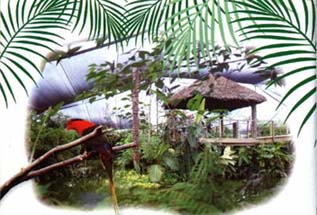 They
have done this by working directly with
local communities, and through liaisons
with the government and international donor
agencies. They have then been able to bring
in companies like Chevron, Kikori Pacific
(a local processor and marketer of sustainable
forestry products), and Collins Pine Co.
(the largest certified timber company in
the US). These companies have found that
not only is conservation good for the earth,
but also for the bottom line. This is because
many New Guineans, upon having their land
damaged by large companies, demand and often
receive large financial compensation. This
has forced many multi-national companies
to think twice before polluting the local
people's land¹. Currently, the WWF
and its partners are pursuing the protection
of more land, continuing the development
of successful programs, training local people
about environmental awareness, and attaining
legal status for Integrated Conservation
and Development Projects in the area. They
have done this by working directly with
local communities, and through liaisons
with the government and international donor
agencies. They have then been able to bring
in companies like Chevron, Kikori Pacific
(a local processor and marketer of sustainable
forestry products), and Collins Pine Co.
(the largest certified timber company in
the US). These companies have found that
not only is conservation good for the earth,
but also for the bottom line. This is because
many New Guineans, upon having their land
damaged by large companies, demand and often
receive large financial compensation. This
has forced many multi-national companies
to think twice before polluting the local
people's land¹. Currently, the WWF
and its partners are pursuing the protection
of more land, continuing the development
of successful programs, training local people
about environmental awareness, and attaining
legal status for Integrated Conservation
and Development Projects in the area.
Concurrently, the WWF is pursuing Community
Land Care Projects in the Sepik Hills,
Trans Fly, and Collingwood Bay areas. The
purpose of this initiative is to preserve
the natural environment, biological diversity,
and cultural heritage in distinct areas
of the country. The project includes the
creation of local and national agencies
to support rural development and conservation.
First, however, models need to be made and
local communities have to be educated and
taught how to protect the land.
WWF also has a program in the Hunstien
Range where they work with the East
Sepik Council of Women, and the Individual
Community Rights Advocacy Forum ICRAF. Since
1992 this project has assisted in legal
representation, community institution building,
providing social services, eco-tourism,
artifact making, and much more. For more
information please contact the WWF website
at www.panda.org.
Along with the WWF Greenpeace
is very active in the Collingwood Bay area.
Greenpeace has been working with the Maisin
people to create the Painting a Sustainable
Future Initiative. Through community
based enterprise, the Maisin have been able
to resist the lure of large scale deforestation
and have created the Maisin Integrated Conservation
and Development organization (MICAD). MICAD
has tapped into the heritage of the local
people, and forged long term partnerships
with museums, universities, government,
companies, and non-governmental organizations,
to promote, market and sell local handicraft,
especially tapa cloth. Tapa is a form of
art that dates back hundreds of years. It
is made from pounded bark and painted with
organic dyes; no two tapa cloths are alike.
Over the years the production and sale of
this cloth has brought in close to $30,000
for the local tribes.
Another one of Greenpeace's major contributions
in PNG includes the enforcing and implementing
of existing laws and legal practices. The
national government all too often is not
able to enforce or monitor industrial activities
in the country. It mostly leaves this up
to the provincial governments, which do
not possess the knowledge or capability
to handle this. Greenpeace is also very
useful in engaging the provincial governments,
and providing data to the national government.
For much information on a variety of conservation
initiatives please go to the Greenpeace
website at www.greenpeace.org.
The Pacific Heritage Foundation
in partnership with the East New Britain
Sosel Eksen Committee, ICRAF, and the Forest
Research Institute, is very active in the
islands of New Britain and New Ireland.
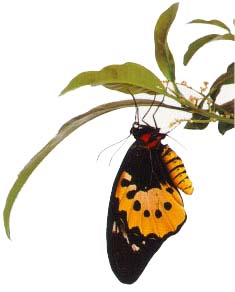 Here many endemic plants and animals are
under threat of being destroyed by large
multi-national logging companies. Even though
the people control the land, they are under
extreme pressure to sell the rights for
a fraction of their true market value. Here
the PHF is pursuing community based monitoring
activities and Integrated Conservation and
Development programs. The challenges are
enormous. With the costs of running for
elections many leaders resort to selling
off their land rights to logging companies.
The PHF hopes to provide a model of how
communities can derive profit without signing
over their forests. Recently they fought
to overturn a law regulating small timber
initiatives, which restricts even the low
impact logging initiatives undertaken locally.
PHF also provides assistance with legal
and biological information. For more information
please go to the PHF website at www.bcnet.org.
Here many endemic plants and animals are
under threat of being destroyed by large
multi-national logging companies. Even though
the people control the land, they are under
extreme pressure to sell the rights for
a fraction of their true market value. Here
the PHF is pursuing community based monitoring
activities and Integrated Conservation and
Development programs. The challenges are
enormous. With the costs of running for
elections many leaders resort to selling
off their land rights to logging companies.
The PHF hopes to provide a model of how
communities can derive profit without signing
over their forests. Recently they fought
to overturn a law regulating small timber
initiatives, which restricts even the low
impact logging initiatives undertaken locally.
PHF also provides assistance with legal
and biological information. For more information
please go to the PHF website at www.bcnet.org.
Clearly the world is a changing place.
With the pressures to industrialize and
modernize many developing nations like Papua
New Guinea are faced with an identity crisis.
It is true, however, that organizations
like the ones here can help to relieve this
pressure, and allow countries to succeed
without selling off their culture and environment
for the sake of making fast money.
¹Information
provided by Jared Diamond, "Paradise
and Oil." Discover, March 1999
|